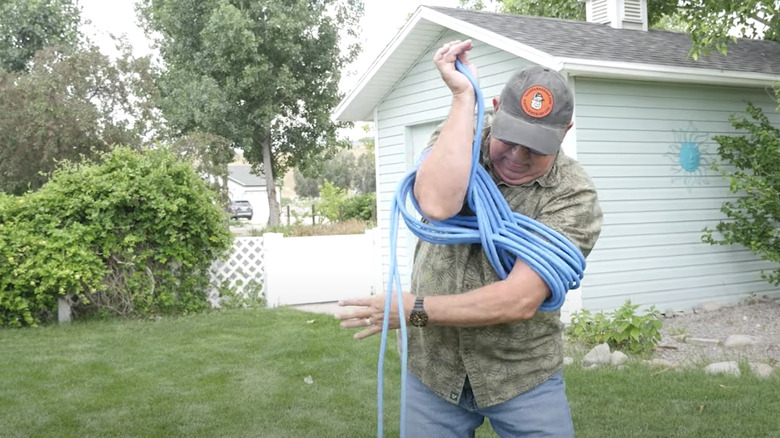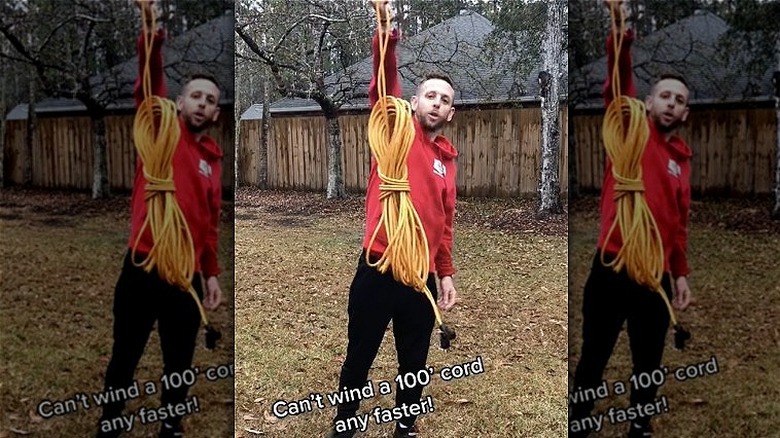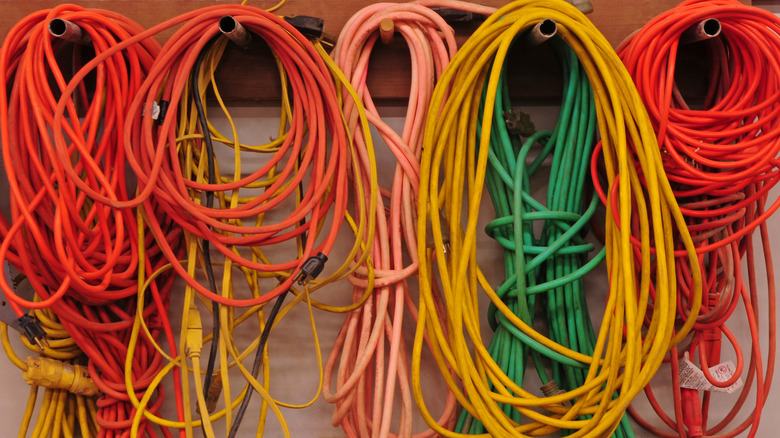The Figure-8 Hack For Wrapping And Storing Extension Cords Tangle-Free
How you coil up an extension cord (or climbing rope, audio cable, or a boat's mooring line) can be a very big deal. For some, like alpine climbers and arborists, good rope-wrapping form is a matter of life and death. For others, like Nick Glassett, it's a matter of being efficient and organized. Glassett is a TikToker, YouTuber, Christmas light installer, and owner of a bounce house rental business, and getting an extension cord wrapped up and ready to go is crucial for doing his job quickly. So his TikTok demonstration of how to coil a 100-foot extension cord is serious business, even if he looks a bit like he's doing a zombie dance.
Glassett starts with both ends of the cable in one hand and, with arms outstretched, repeatedly loops the cable in a figure eight by reaching under the cord with one arm and then the other. One loop of the "eight" hangs on his right arm, and the other on his left. When he nears the end, he wraps some of the remaining cable around the loops, then passes the tag end through one side to lock everything in place and create a loop to hang the cord from. This is handy; while there are easy hacks for organizing short cords and chargers, long cords can be difficult to store. Maybe it all sounds, and looks, a little awkward, but as Glassett says, you won't find a faster way to wrap a 100-foot extension cord.
Which cords work best with the hack?
Professionals can be picky about the "right way" to wrap a cable or a rope, and this figure-eight method isn't the right way for every job. It works best when you can have both ends of the cable in hand when you start. This allows you to wind a doubled cable, which cuts the coiling time in half. The wrap-and-pass-through "knot" used to finish the coil is often used for boat anchor lines, which demand reliability; you don't want to be untangling a rope when you need to drop anchor. This method also takes advantage of the fact that, when dealing with a sturdy electrical cord, you can be a little more aggressive than with more delicate data/signal cabling. And in the process, you get to distribute the weight between both arms rather than holding a heavy cord in one hand.
When it comes to storage, you will need to hang the cord by its tag end so your coil will hold together, and so you can easily pass it back through your loop to quickly unwrap the cord without tangling.There are ways to lock this tag end in place with a couple of extra steps often featured in the butterfly coil process used by arborists and climbers, per YouTube. But, while using that knot with rope works great, putting tight, small-diameter kinks in an electrical cable can damage the wires within.
How to wrap shorter cords
Short extension cords are less likely to tangle, and different methods can work for those. The figure-eight hack wouldn't work on a 6-foot Christmas tree light cord, for example. In the video production industry, shorter AC cables are wrapped using the "over-over" method, in which the cord is looped in small, uniform coils. Messy tangles are prevented by gently twisting the cord as you wrap so that each coil lies flat against the previous ones. This works for short cables because the tag end is free to spin away any unevenness in the twist, but since you only twist in one direction, this could create a pronounced (and potentially damaging) amount of tension in a longer cord. YouTuber @readiysteadiy demonstrates this method, and the alternative that many pros use instead: the "over-under" method, which can help you keep your extension cords tangle-free using an alternating twist direction to prevent over-twisting.
The figure-eight hack improves on the over-under method for long extension cords by distributing the weight between both hands and by allowing you to coil quickly with a doubled cord. Both the over-under method and the figure-eight hack can become tangled if the tag end gets pulled in the wrong direction, but the figure-eight method has that built-in hanger to remind you how to avoid this. It's a brilliant solution that lets you work fast without damaging your cord or quickly wearing out one arm.


